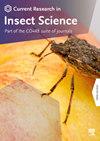Heritability of body size matches trait evolution in the range expansion of a biological control agent
IF 2.7
Q1 ENTOMOLOGY
引用次数: 0
Abstract
Adaptive evolution requires both natural selection and genetic variation. In introduced species, the selective dynamics of range expansion are predicted by theory to lead to differences between the core and the leading edge, with edge individuals evolving to be more fecund (under r-selection) and have greater dispersal ability than core individuals. In arthropods, both fecundity and dispersal ability are often positively correlated with body size. Here, we quantify genetic variation available for evolution of body size in a beetle (Diorhabda carinulata) introduced into North America as a biological control agent. Previously, we found that females at the edge of the range expansion have evolved to be larger than those at the core as predicted by theory, while male body size has not clearly changed, despite the evolution of increased dispersal capacity. Using a half-sib mating design, we measure genetic variation in mass at eclosion and thorax width of female and male beetles from a single introduced population at the core of the range expansion. We find significant heritable genetic variation in females in both traits, but not in males. Thus, lack of genetic variation in body size may preclude evolution of size in males along this expansion front.
在生物防治剂的范围扩展中,体型的遗传力与性状进化相匹配
适应性进化既需要自然选择,也需要遗传变异。在引进物种中,理论预测范围扩展的选择动态导致核心和前沿个体之间的差异,边缘个体进化得比核心个体更多产(在r选择下),并且具有更大的扩散能力。在节肢动物中,繁殖力和扩散能力往往与体型呈正相关。在这里,我们量化了一种甲虫(Diorhabda carinulata)作为生物防治剂引入北美的体型进化的遗传变异。在此之前,我们发现,在范围扩张边缘的雌性已经进化到比核心的雌性更大,这与理论预测的一致,而雄性的体型并没有明显的变化,尽管进化增加了扩散能力。采用半同胞交配设计,我们测量了在扩展范围的核心的单个引进种群中雌甲虫和雄甲虫的羽化质量和胸宽的遗传变异。我们发现女性在这两种性状上都有显著的遗传变异,但在男性中没有。因此,缺乏身体大小的遗传变异可能会阻碍雄性沿着这条扩张前沿的大小进化。
本文章由计算机程序翻译,如有差异,请以英文原文为准。
求助全文
约1分钟内获得全文
求助全文
来源期刊

Current Research in Insect Science
Agricultural and Biological Sciences-Animal Science and Zoology
CiteScore
3.20
自引率
0.00%
发文量
22
审稿时长
36 days
 求助内容:
求助内容: 应助结果提醒方式:
应助结果提醒方式:


